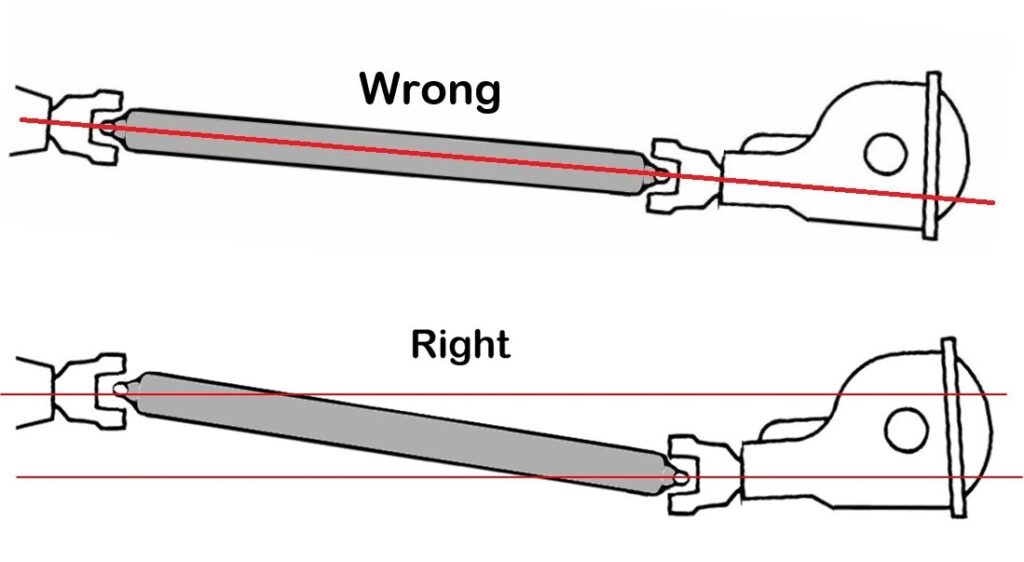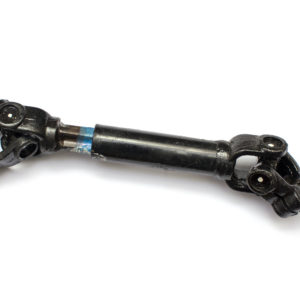Pinion angle change is an essential part of ride height adjustment, but it isn’t a topic that often comes up in everyday vehicle repair talk. Pinion angle is an important part of keeping even average street cars driving smoothly. Let’s take a look at what pinion angle is and what it does for your vehicle.
What Is Pinion Angle and Why Does It Matter?
Pinion angle is the angle of the differential pinion in relation to the driveshaft. The driveshaft runs between and connects the transmission to the differential. As the transmission rotates, so does the driveshaft, transferring that mechanical energy to the differential so it can spin the wheels.
In most modern vehicles, u-joints connect the driveshaft to both the transmission and the differential pinion. When the two linked u-joints aren’t bent, they spin entirely in sync. The transmission, driveshaft, and differential pinion all rotate at the same speed.
While it may seem counterintuitive, the driveshaft doesn’t need to be perfectly aligned with the transmission output and the final drive input. They need to be slightly out of line to ensure long-lived smooth operation of the U-joints.
U-joints allow for flexibility and movement in the driveline, accommodating changes in angle and distance between the transmission and the driveshaft.
When the transmission and driveshaft are perfectly aligned, the U-joints can’t flex and their needle bearings take a beating because they’re not rolling within their races. They need to move freely just enough to avoid excessive wear.
But with a slight misalignment (which is proper), the U-joint needle bearings will rotate smoothly, extending the lifespan of the U-Joints.

How Pinion Angle Affects Driving
Pinion angle isn’t always fixed. As you drive, the pinion naturally shifts whenever your vehicle hits bumps on the road and when the final drive tilts with torque. However, manufacturers design their vehicles to maintain the optimum pinion angle as often as possible. They make it so when the pinion angle changes, the differences are so miniscule that you wouldn’t notice the extra vibrations too much. For the most part, the average driver doesn’t need to worry about pinion angle at all.
You’ll only need to keep an eye on pinion angle if you start customizing your vehicle’s suspension for things like drag racing or simple aesthetics. For instance, say you adjust your vehicle’s ride height. Ride height adjustments can significantly misalign the pinion angle from the transmission shaft angle. When the angles aren’t parallel anymore, you’ll wear down your vehicle’s driveshaft more quickly and feel more vibrations while driving.
The optimal pinion angle for customized vehicles generally depends on the type of suspension the vehicle has and how much control you need from your vehicle’s rear suspension. For instance, a four-link suspension needs a pinion angle of one to two degrees, while a leaf-spring suspension needs six to seven degrees.
Calculating Pinion Angle
If you want to measure your vehicle’s pinion angle, it’s best to also measure all the driveline angles, which are the angles associated with the driveshaft. You get a better picture of the system this way.
Engine and Transmission Measurement
First, pick up an angle finder and a straightedge and find a flat surface on the engine or transmission. A good place is usually the crankshaft pulley. Set your straightedge against it and measure the angle using the angle finder.
Driveshaft Measurement
Next is the driveshaft angle. You can get this angle by setting your angle finder anywhere along the driveshaft. Check to see if the angle is a negative or positive number. This helps you find out whether the differential is pointing up or down.
Differential Measurement
Finally, you can measure pinion angle by setting your straightedge against a flat surface on the differential right beside the driveshaft. Measure the angle with your angle finder and jot it down along with the other angle measurements.
Pinion and Transmission Shaft Angles
Once you have your measurements, you can plug them into an online calculator, which will tell you your vehicle’s pinion and transmission shaft angles.
Changing Pinion Angle
It’s best to leave changing or adjusting your vehicle’s pinion angle to the professionals. It might involve customizing suspension or transmission parts, and you need to make sure the vehicle’s sitting at ride height with the suspension loaded when making adjustments. There are kits and specialized parts to make changing the pinion angle easier, but it’s still a tough project that might leave your vehicle with a busted suspension system and incorrect driveline angles overall. If you ever choose to tackle setting the pinion angle yourself, then at least you now know why it’s so important to get it right.
Where to Get a Replacement Driveshaft for Your Vehicle
A damaged or worn driveshaft makes it hard to drive your vehicle, and we know how important it is to get it repaired or replaced quickly. Thankfully, CarParts.com has a variety of driveshafts for you to choose from!
We’ll ship your order from the distribution center nearest you, so you can get back on the road in a matter of days.
Need to ask a few questions before deciding on your order? Our toll-free lines are open 24/7. Our team members will be happy to answer any questions you may have about our products, whether they’re about fitment or shipping.
Shop at CarParts.com today!
Any information provided on this Website is for informational purposes only and is not intended to replace consultation with a professional mechanic. The accuracy and timeliness of the information may change from the time of publication.
































